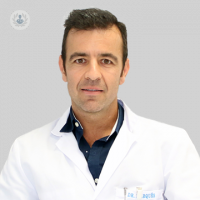Una aproximación a la cirugía endoscópica de columna, por el Dr. Alberto Marqués
Written by:Endoscopic spine surgery , also known as minimally invasive spinal surgery , involves trying to apply the same principles of open surgery, but making the least possible aggression to the patient's structures.. For this a small incision of about 15 millimeters is made, where a cannula of that size is placed and inside this cannula we introduce an optic that allows us to enlarge and magnify the work field, therefore, it does not force us to perform large Dissections to access the patient's spine.
Origins of endoscopic surgery
Endoscopic surgery is also called 'Minimally Invasive Surgery'. This method began in the mid-70s with arthroscopies, such as knee or shoulder among others. In the 80s, progress continued with endoscopies (abdominal, urogenital, etc.) and currently with the new endoscopic spinal surgery.
In recent years, technological advances in the field of spinal surgery have been very large with very positive results, since the risk of complications is greater when the complexity of the intervention is greater.
A little over ten years ago, and once his training as an arthroscopic surgeon specializing in shoulder pathology was completed, Dr.. Marqués began to apply these techniques of minimally invasive surgery to conventional spine surgery. The objective, very simple: to ensure that patients with spinal injuries could benefit from the advantages of minimally invasive surgery in the same way as patients with lesions in other joints that already did so thanks to arthroscopic techniques.

Advantages of endoscopic surgery compared to other techniques
The advantages offered by minimally invasive surgery or endoscopic surgery compared to conventional surgery are very numerous. Some of them are the following:
- Minor incision with reduction of muscle tissue trauma.
- Reduction in the rate of infections.
- Less postoperative pain, with decreased consumption of analgesics.
- Shorter hospital stay. The fact of making hardly noticeable incisions diminishes the need to remain hospitalized and accelerates the recovery.
- Prompt postoperative reinsertion to the daily and labor activity.
- Better aesthetic appearance. The scar does not exceed 1.5 - 2 centimeters.

Postoperative and return to normal after endoscopic surgery
Usually, the process for both a herniated disc surgery and an endoscopic canal stenosis surgery is as follows: the patient enters in the morning, that same morning he is operated on, stays for one day admitted and the next day in the morning He is discharged from hospital .
The patient is living a normal life, practically since he leaves the hospital, with the limitations that can generate his discomfort, without sports activities or aggressive exercises.
In fact, up to 90% of patients go home the day after surgery and are allowed to live a normal life, although without sports or heavy activities. The stitches are removed after two weeks and you are discharged six weeks after surgery. It is therefore a surgery that allows us, through a minimum of aggression, to increase the quality of life of patients.
The mean age of the patients operated on by this technique in the last two years has been 75 years, varying the age range between the 27 years of the youngest patient and 95 years of the oldest.
For more information about endoscopic surgery, consult a specialist in minimally invasive surgery or a specialist in Traumatology .


